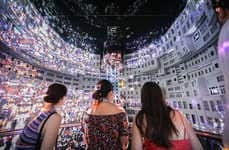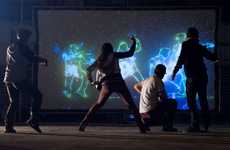



Tech allows artwork to better tap into viewers' emotional responsiveness
Trend - The adoption of emotion-responsive technology in exhibitions is prompting audiences to contribute to art pieces. Whether incorporating facial-recognition technology or movement and behavioral responsiveness, these installations curate a personalized gallery experience where the artwork mirrors the viewer's state of mind.
Insight - The incorporation of behavior-responsive technology into art installations comes as institutions and artists within this space seek out ways to appeal to Millennial and Gen Z consumers. Since individuals within these demographics respond better to immersive and experiential purchase journeys, responsive art is able to facilitate more intimate interactions and relationships with those who observe it.
Insight - The incorporation of behavior-responsive technology into art installations comes as institutions and artists within this space seek out ways to appeal to Millennial and Gen Z consumers. Since individuals within these demographics respond better to immersive and experiential purchase journeys, responsive art is able to facilitate more intimate interactions and relationships with those who observe it.
Workshop Question - What is a behavior-based activity or installation that could benefit your business?
Trend Themes
1. Emotion-responsive Technology in Art - Incorporating behavior-responsive technology into art installations is gaining ground as it appeals to experiential purchase journeys of Millennials and Gen Zs.
2. Brainwave-controlled Interactive Art - Interactive artworks like 'Mind Over Matter' that react to the received stimuli from EEG headbands are becoming increasingly popular and represent a perfect cross-over between art, science, and technology.
3. Co-creation Through Immersive Environment - Highly immersive environments such as Samsung's 'Resonance' allow co-creation of art with the audience and offer deeper immersive experiences based on behavioral cues and patterns of the individuals.
Industry Implications
1. Art & Culture - Artists and institutions are finding new ways to appeal to Millennial and Gen Z consumers through the adoption of responsive and immersive art installations.
2. Technology - Rapid advancements in technology, especially in behavior-responsive technology, virtual reality, smart sensors, and facial recognition, are contributing to new forms of interactive and immersive art installations.
3. Experience Economy - Responsive and immersive art installations offer a unique and personalized experience, catering to the growing demand of consumers in the experience economy.
4 Featured, 26 Examples:
231,019 Total Clicks
Date Range:
Aug 18 — May 19
Trending:
V. Hot
Consumer Insight Topics:


























